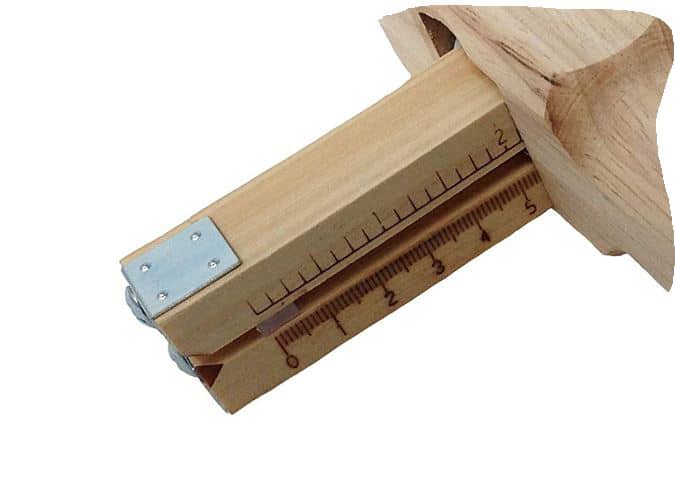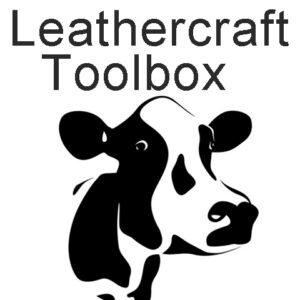One of the easiest and most basic items to make when you are getting started in leathercraft is a belt. There are relatively few parts, the buckle is manufactured and once the belt length is cut there are only few holes that need to be made. Cut the belt end and stitch the belt loop together with the buckle and voila!! If this is your first attempt at making a belt then this blog post is for you as the strap cutter will make belt making much easier.
A strap cutter is an adjustable wooden handheld tool that consists of a blade and gauge which can be set for cutting specific widths and thicknesses of leather eg. belts. The strap cutter is manually pulled along the edge of a leather hide as the blade cuts a length of even width strap or belt.
In this post i discuss the advantages of strap cutters, how much they cost, how they work and what they are used for. If you are new to leathercraft and are keen to learn more, read on for some more info on the humble strap cutter tool.
What is a Strap Cutter used for.
A Strap cutter is used to cut long lengths of equal width leather eg. a leather belt or strap. Say you wanted to make a belt that is 2 inches wide, you would set the gauge/ ruler on the strap cutter at 2 inches and that would allow you to cut a nice even length of leather set at 2 inches.
It can be set to cut very specific widths of leather, from half inch up to about 4 inches usually. If you need to cut wider straps then it’s best to use another tool called a draw gauge. All you need is a nice long piece of leather and a good stable work surface in order to cut the desired length. A strap cutter will cut different types and thicknesses of leather as it can be adjusted for thickness as well as width for different types.
What are the various parts of a Strap Cutter.
A Strap cutter is usually made of timber. Older strap cutters were made out of hard wood and were very durable and lasted forever. Today most of them are made out of soft wood and aren’t as hard wearing as the hardwood variety. Saying that, if you look after your cutter you should have it for a good few years anyway.
The strap cutter consists of a 3 timber parts. A wooden handle with a rectangular slot cut out whereby 2 parallel timber pieces fit and slide through this slot. See image above. The handle is usually quite bulky, particularly if you have small hands, but you should be comfortable with it after a few practice tries.
There is a sharp replaceable steel blade that fits in between these 2 parallel pieces of timber and is held in place by 2 screws. These screws can be untightened in order to remove and replace the blade. The blade is not exposed and doesn’t protrude outside these timber pieces so it’s a fairly safe tool to use. Just be careful when handling it as the blades are sharp.
The strap cutter can be adjusted to cut various thicknesses of leather. Just unscrew the wing nut that holds the 2 timber pieces together. This will adjust/alter the space between the timbers allowing for thicker or thinner leather to be cut by the blade.
The cutter can also be adjusted to cut wider or narrower leather straps or belts. Situated at the top of the wooden handle is another wingnut that can be adjusted. You will notice that there is a ruler with measurements on the 2 pieces of parallel timber pieces. Usually shown in inches and millimetres that can be set by sliding the 2 pieces of parallel timbers in our out of the slot. Set the ruler to your required measurement and tighten the wing nut and you are ready
start cutting leather.

How to use a Strap Cutter.
It’s a relatively easy tool to master and once you have cut a few test straps you should be ready for the real thing. Having said that though there are a few important steps that i would like to discuss before you begin cutting.
- Firstly you will need a nice big cutting surface, preferably a table when using this tool. Belts for men are usually around 32 inches (1000mm) long and up so you will need an adequate cutting surface to handle this kind of length.
2. You will need to use a straight edge/ long steel ruler on your hide before you use the strap cutter. This is because leather hides never come with perfectly straight or parallel sides and the edges are usually rough. Use your steel ruler to cut a nice long even straight edge on your hide/ skin.
3. Once this step is completed you should now set the thickness and width on your strap cutter. This needs to match the leather thickness you are using and also needs to be set to the width strap/ belt you want to cut out.
4. Now you are ready to cut. Place the strap cutter at the top end of your leather hide. This is where you want to start your cut and pull the cutter towards you. Position your blade. Make sure that the side of the strap cutter is placed against the edge of your leather hide. This will allow you to cut straight when you pull the cutter towards you.
5. Remember there is no rush, just work slowly and methodically and gently pull the cutter towards you thereby cutting the leather.
6. It does help if you are cutting/ holding the strap cutter in your right hand, to hold the strip that is being cut with your left hand as you pull the cutter towards yourself. The numbers on the ruler should be facing you as you cut and keep the cutter flush with the leather edge as you cut. Pull all the way until the leather cut is complete and you now you have one belt blank.
7. Repeat this process again and again until you become an expert!
How much do Strap Cutters cost.
Strap cutters vary in price as most tools do depending on the quality of the tool and depending on your specific needs. A basic entry level strap cutter will set you back about $15 on Amazon. Not too expensive for a beginner but if you do want something that will last a long time or at least a couple of years then its best to fork out a little bit more say $30 and get a slightly more durable rigid model. Check out this link to the various options on Amazon.
Tandy Leather does offer a reasonably priced strap cutter as well. Here is the link to Tandy
There are a couple of websites that have done reviews on strap cutters so be sure to check those out. They are all very similar in price and specification. Some come with spare blades while others only come with one blade. A set of 5 blades for a strap cutter will cost about $5.80 on Amazon. A point to note is that some strap cutters use old school razor blades that need to be cut down to size in order to fit in the strap cutter. These blades are fairly cheap if you don’t mind cutting them to fit.
Helpful hints and tips when using a Strap Cutter.
A strap cutter is a great tool to have in your workshop but there are limits to what it can do.
- It can only cut widths from about 1/2 inch to about 4 inches wide. Any wider than that and you will need to either use a draw gauge or a plough gauge to cut wider pieces. Any narrower than 1/2 inch and it becomes quite tricky to hold the leather and cut at the same time. It will be easier on thicker stiffer leather.
2. Its easier to cut slightly thicker leather with a strap cutter. Thinner leather, like chrome tanned leather can be tricky to cut and you will need to make sure your blade is super sharp when cutting thinner leather. Remember to adjust your thickness on your cutter.
3. The blades are replaceable and need to be changed quite regularly when cutting thicker leather. Sharp blades will give you the neatest cut.
4. Keep all the screws/ wingnuts quite tight when you are cutting as this will affect your cut and cause you to cut skew should they become loose.
5. Always look after your tools and store them in a safe place when they are not in use.

Conclusion
My conclusion about the strap cutter is that it is definitely a tool that one should invest in and is worth having in your toolbox. They are relatively cheap, easy to use and last a long time. Thanks for reading my blog post, i hope you found it helpful and managed to learn something new about leathercraft. Please check out some of my other articles on leathercraft tools if you would like to learn some more. Thank you.
